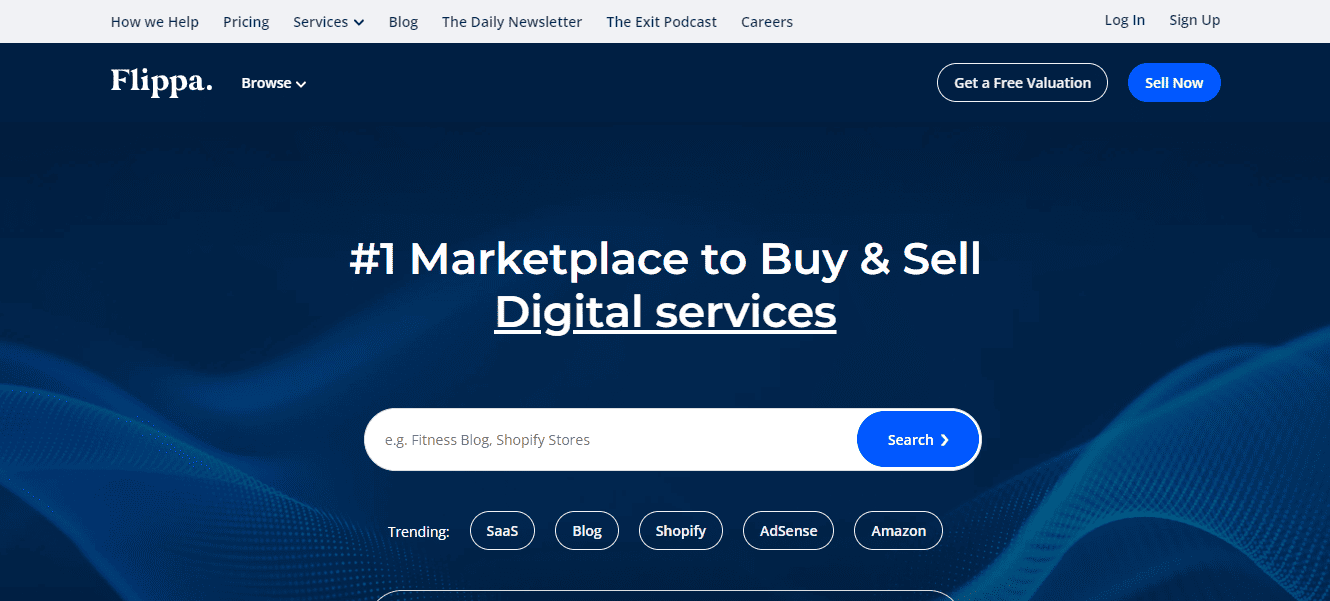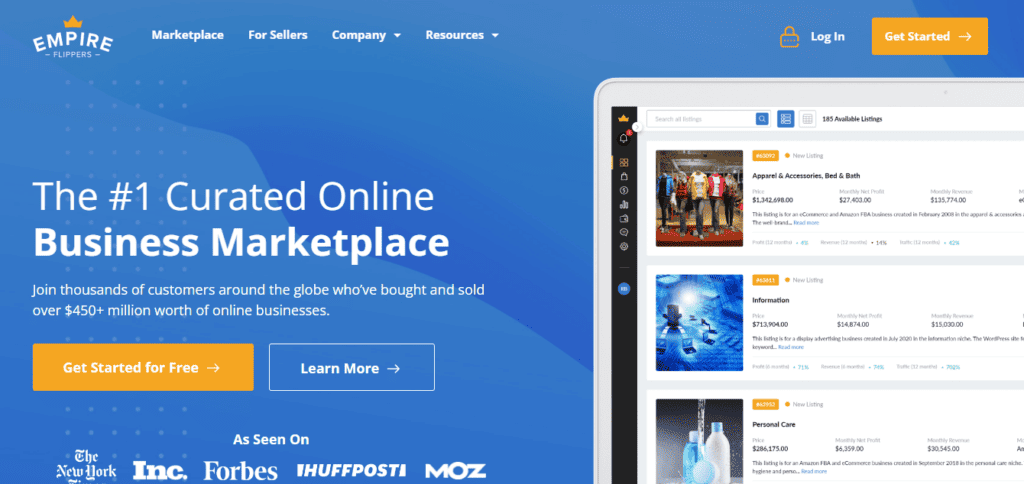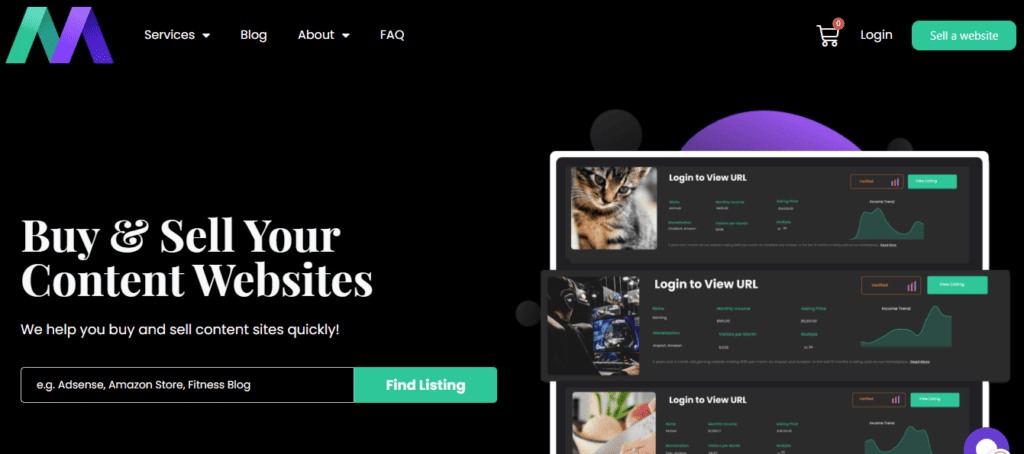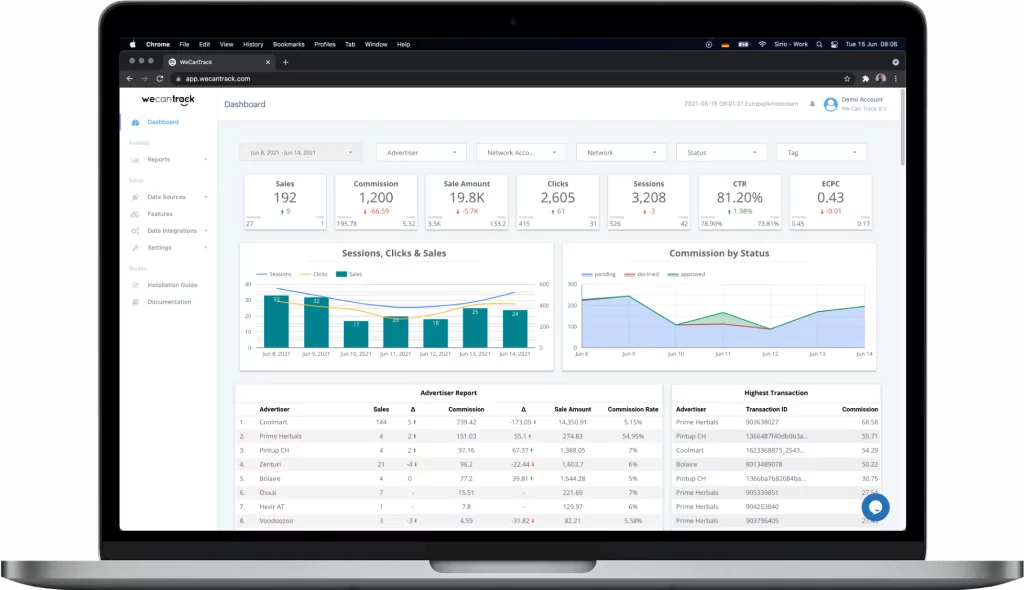Buying a profitable website is a great way to expand your passive income empire. It can also help businesses establish their online presence in a market quickly or venture into a new niche.
Whatever your reason for interested in buying an existing website, it’s important to do the necessary research and take your time to prevent yourself from buying a pig in a poke.
In this article, we’ll tell you exactly what to look out for and the best places to look out for.
Buying a Profitable Website: A Step-by-Step Guide Overview
Why And When Buying A Profitable Website Is A Good Idea
Acquiring an already profitable website can be a smart move for any business looking to expand their online presence. It’s also an excellent option for anyone looking to expand their affiliate business without going through the complex and time-consuming process of building a new website.
Not only does it provide a ready-made audience and revenue stream, but it also saves the time and resources required to build a new website from scratch.
However, buying a profitable website can be a complex and time-consuming process. It is essential to do your due diligence and thoroughly research the website before purchasing.

Key factors in assessing website profitability include traffic quality, revenue diversification, and operational costs. Evaluate market trends, competitor landscape, and the website's potential for expansion and optimization.
10 Steps To Buy A Profitable Website
Here is a 10 step guide on how you can buy a profitable website for your business:
Step 1: Research Potential Websites
Research is the foundation of the website acquisition process. Thoroughly investigating potential websites is essential to ensuring that they meet your business’s needs and have the potential to generate revenue.
Here are some key factors to consider when you are trying to assess whether a website is worth making an offer on:
- Value proposition: A website’s value proposition is the unique benefit it offers to its visitors. Understanding a potential website’s value proposition is essential, as it will determine its appeal to potential customers and its ability to generate traffic and revenue. Would this website attract the type of audience you’re looking for?
- Current traffic: The amount of traffic that a website receives is a key indicator of its potential value. Utilize tools such as Ahrefs or SEMrush to gather information on a website’s traffic and engagement. These tools provide valuable insights into the keywords a website is ranking for, which can help you determine the website’s potential value to your business.
- Scope of operations: The scope of operations refers to the types of products or services that a website offers. It’s important to understand the scope of a website’s operations, as it will determine its potential to generate revenue for your business.
- Reputation: The reputation of a website is another important factor to consider when researching potential websites. Look for reviews, testimonials, and case studies to get a sense of the website’s reputation. Check the website’s social media profiles to see the type of engagement it receives from its audience.Once again, you can use tools like Ahrefs and SEMrush to get an idea of a website’s overall reputation and trustworthiness.
- History: The history of a website is important to research because it can provide insights into its past performance and future potential. Look for information such as how long the website has been in operation, who the previous owners were, and how it has evolved over time.
- Competition: The competition in the market can provide a sense of the difficulty in running the website and how many competitors are in the space. Look at the top websites in the same niche and investigate their traffic, revenue, customer acquisition cost, and other important data that can give you an idea of how difficult it is to succeed in that market.
Step 2: Analyze Data
Once you have identified a potential website through your preliminary research, it’s time to examine the available data to better understand its performance and ability to generate income. The data you gather will be critical in determining the website’s potential value to your business.
You can use tools like Ahrefs, SEMrush, and Ubersuggest to get a preliminary idea of a website’s traffic. However, to get the complete picture, you will need access to the website owner’s data.
So after first contact has been made and the owner turns out to be open for selling the website, ask if you could access Google Analytics data from the site. Google Analytics is a powerful tool that provides detailed insights into a website’s performance.
To help you get the right insights, here are some important metrics to look at when analyzing a website’s data:
- Page views: This metric measures the number of pages on the website users view. A high number of page views indicates an engaged audience.
- Bounce rate: This metric measures the percentage of visitors leaving the website after viewing only one page. A high bounce rate may indicate that the website’s content is not engaging or relevant to its audience.
- Time on site: This metric measures the average amount of time visitors spend on the website. A high time on site indicates an engaged audience.
- Conversion rate: This metric measures the percentage of website visitors who take a desired action, such as making a purchase or filling out a form. A high conversion rate indicates that the website is effective at converting visitors into customers, meaning there is a lot of potential to generate revenue from them.
- Revenue: This metric measures the total revenue generated by the website. Understanding how the website makes money and its revenue stream(s) is important.
Step 3: Negotiate The Purchase
Once you have identified a potential website through your research and analysis of data, it is time to negotiate the purchase with the website’s owner. It is essential to get the best possible deal on the website while also verifying its authenticity and legal compliance.
- Negotiate pricing: Based on the data you have collected during the research and analysis process, determine a fair price for the website. Consider factors such as website traffic, revenue, potential growth, and industry trends. Usually, a good starting point is the website’s annual revenue multiplied by a factor between 3 and 5, based on its potential. Be prepared to negotiate the price with the website’s owner and work towards a mutually beneficial agreement.
- Verify authenticity: Before finalizing the deal, ensure the website is authentic and legally compliant. Verify the website’s domain registration, check for any necessary licenses or permits, and ensure the website does not infringe on intellectual property rights. Having a legal professional review the website’s legal compliance and any contracts or agreements is also a good idea.
- Review purchase agreement: Review and understand the purchase agreement and ensure it covers all the necessary details including the purchase price, any warranties, contingencies, and payment terms.
- Consider post-sale support: During the purchase process, it’s a good idea to negotiate post-sale support from the current owner. This could include website transfer assistance, employee training, or extended consultation.
Step 4: Establish An Affiliate Tracking System
Once you have purchased a profitable website, it is important to set up a tracking system to measure its performance and income generation.
Setting up an affiliate tracking system will help you monitor important metrics such as traffic, clicks, conversions, and customer engagement.
A few affiliate tracking systems are available, and you will want to choose one that is easy to set up and use, like Wecantrack. This system provides the data you need to monitor website performance in one comprehensive affiliate dashboard.
Once you have chosen an affiliate tracking system, set it up on your website. This may require installing tracking code or adding a tracking pixel to your website. You’ll also want to familiarize yourself with how to access, read and interpret the data that the tracking system provides.
Track important metrics. It’s important to track the following metrics:
- Traffic: Monitor the number of visitors to your website, including the number of unique visitors, returning visitors, and the percentage of new visitors.
- Clicks: Monitor the number of clicks on links and buttons on your website, including clicks on affiliate links.
- Conversions: Monitor the number of visitors who take a desired action, such as making a purchase or filling out a form.
- Customer engagement: Monitor how engaged visitors are with your website, including the time spent on it and the pages they visit.
Step 5: Implement Marketing Strategies
Once you have set up an affiliate tracking system, you can use the data it provides to identify areas for improvement and implement effective marketing strategies to grow traffic and conversions.
Here are a few ideas to bring more and better converting visitors to your site:
- Search Engine Optimization (SEO): Optimize your website’s content and structure to improve its visibility on search engines. This can include keyword research, meta tag optimization, and content creation.
- Social Media Marketing: Use social media platforms to promote your website and engage with your audience. Create a social media presence for your website and use it to share valuable content and connect with your audience. Certain social media topics, like affiliate marketing with Instagram, have grown considerably in recent years, and there are still many opportunities for growth. This can help you increase your website’s visibility and attract new visitors.
- Content Marketing: Create valuable and engaging content for your website. A blog, for example, can help you attract new visitors to your website and keep current visitors engaged.
- Email marketing: Build a list of email subscribers and regularly send them promotional emails, news, and updates about your website. Email marketing can help you increase conversions and retain customers.
Step 6: Monitor Performance
Once you have implemented strategies to increase traffic and conversions on your website, monitoring the website’s performance and making adjustments as needed is essential. This will help you identify areas for improvement and ensure that your website remains profitable.
Here are some ideas to help you structure this:
- Use affiliate tracking system data: Use the data provided by your affiliate tracking system to monitor the website’s performance. This includes monitoring traffic, clicks, conversions, and customer engagement.
- Identify areas for improvement: Use the data to identify areas where the website is underperforming. For example, a high bounce rate may indicate the website’s content is not engaging or relevant to its audience.
- Make adjustments: Make adjustments to the website as needed to improve its performance. This could include changing the website’s design, content, or marketing strategies.
- A/B testing: Conduct A/B testing on different website elements, such as headlines, calls-to-action, and landing pages, to determine what works best and what does not.
- Monitor key performance indicators (KPIs): Monitor and track key performance indicators (KPIs) for the website, such as revenue, customer acquisition cost, and profit margin.
Step 7: Analyze Results
Once you have been monitoring the website’s performance, it’s time to analyze the results of your efforts, to determine which strategies have been successful and which ones have not. This will allow you to make informed decisions about optimizing your efforts and improving the website’s profitability.
Identify what is working by looking for trends in the data. Identify which strategies are driving the most traffic, conversions, and revenue. Even more important, identify what’s not working and try to figure out why this is the case. This can help you eliminate efforts that cost more—both in budget and in hours—than they’re yielding.
Adjust the website and marketing strategies as needed to improve its performance. For example, if a strategy is not working, try a different approach or discontinue it. Continuously test new strategies, optimize existing ones and monitor to see how well it performs and makes adjustments accordingly.
Step 8: Evaluate Return On Investment (ROI)
After implementing strategies, monitoring performance and analyzing results, it’s important to evaluate the return on investment (ROI) of your website acquisition. This will help you determine whether your investment in the website was a profitable one, and provide you with a clear picture of the website’s financial performance.
This will also help you determine whether investing in another website is a good idea or whether it still needs too much attention and budget.
- Calculate ROI: Use financial metrics such as revenue, profit, and return on investment (ROI) to evaluate the website’s performance. You can use the data from the affiliate tracking system and financial records of the website to calculate these metrics. You can also set up an integration with Google Ads or have a look at our Affiliate Marketing with Google Ads guide that will allow you to setup automatic reports and immediately spot the ROI and Profitability of your paid activities.
- Compare performance: Compare the website’s performance to industry benchmarks and similar websites in your niche.
- Identify areas for improvement: Identify areas where the website’s performance can be improved, and make adjustments to increase ROI.
- Create a budget: Create a budget for the website, including expenses such as marketing, employee salaries, and website maintenance.
- Evaluate long-term potential: Evaluate the website’s long-term potential, including its ability to scale, adapt to changes in the market, and compete with similar websites.
Step 9: Monitor Market Trends
Staying up-to-date on the latest industry trends is important in order to identify potential opportunities and threats that may impact the performance and profitability of your website.
Research and monitor industry trends to identify potential opportunities and threats. This can include new technologies, shifts in consumer behavior, and changes in regulations that may impact your website.
Analyze competitors’ performance in your niche, including their traffic, revenue, marketing strategies, and customer engagement.
Identify potential opportunities for growth and expansion, such as new markets or product offerings that could benefit your website.
Address potential threats to your website’s performance and profitability. Stay informed by reading industry publications, attending conferences and events, and following industry leaders on social media.
Step 10: Plan For Growth
After successfully buying and optimizing a profitable website, it’s important to set goals and plan for future growth to maximize profits. This includes developing a strategy to scale the website, increase revenue, and drive customer engagement.
Set clear and measurable goals for the website, such as increasing traffic, revenue, and customer engagement. Develop a growth strategy that outlines the actions you will take to achieve your goals. This can include expanding to new markets, introducing new products or services, or improving website performance.
Identify potential opportunities for expansion and growth, such as new product lines or markets to target. Create a budget for future growth and expansion, including expenses such as marketing, employee salaries, and website maintenance.
Invest in new channels, for example TikTok Ads for affiliate marketing it’s another huge opportunity for growth and you can easily create an extra revenue stream and reach a different audience.
Monitor the website’s performance regularly to ensure that it is on track to meet its goals and make adjustments as needed.
3 Best Places To Buy A Profitable Website
Now that you know the steps for buying a profitable website and how to grow your new site, here are some of the best places to buy a profitable website:
Flippa.com
With more than 600,000 monthly searches from buyers and investors seeking to acquire digital businesses, Flippa has more buyers than any other platform and thousands of website listings to choose between.
Mark Harbottle and Matt Mickiewicz founded SitePoint in 1999. They created Flippa as SitePoint Marketplace but spun it off as a separate website in June 2009.
Flippa remains a privately owned company but raised funds from many investors to get where it is today. Investors include OneVentures, Andrew Walsh (Ex-CEO Hitwise, acquired by Experian), Gabby & Hezi Leibovich (founders of Catch.com.au), Guy King and Bevan Clarke (founders of RetailMeNot.com), Tim O’Neill and Tim Fouhy (founders of Reactive Media).
Flippa invented the space for buying and selling digital businesses.
What started as a new bootstrapped startup quickly became the #1 go-to site for investing in profitable websites internationally.
With thousands of website listings to choose from, you might think that finding a profitable website can be a daunting task. However, the way Flippa displays listings is very user-friendly.
You can search for websites based on price, age, and category. In addition, you can narrow your search to starter or established sites.
Options include:
- Shopify Stores for Sale
- Dropshipping Businesses for Sale
- Google AdSense Websites for Sale
- Amazon FBA Businesses for Sale
- Amazon Affiliate Websites for Sale
- SaaS Businesses for Sale
- Blogs for Sale
- Affiliate Websites for Sale
- WordPress Websites for Sale
- Ready Made Websites for Sale
- Turnkey Websites for Sale
- Internet Businesses for Sale
- Travel Websites for Sale
- Pet Websites for Sale
- Online Wedding Business for Sale
- Dating Websites for Sale
Sellers can sell their website directly through the platform or with the assistance of a broker or M&A (mergers and acquisitions) advisor.
And Flippa offers helpful optional services, namely:
- Acquisition finance (through one of their finance partners)
- Due diligence – a verification and assessment service by Flippa, starting at $1,500
- Legal services, starting at $1,000 (recommended where the purchase price exceeds USD$10,000)
Today, Flippa has over 40 employees and 3 million registered users – the site processes 4,000+ business valuations monthly, totaling over $340 million.
According to Similarweb, Flippa.com gets about 1.6 million visits monthly.
EmpireFlippers.com
Empire Flippers is a hybrid between a marketplace and a full-service brokerage – websites must comply with many requirements and pass the scrutiny of their vetting team before being allowed on their marketplace.
But perhaps the most important feature for investors looking to buy a profitable website is that only sites making at least $2,000 on average per month over 12 months are accepted.
Empire Flippers was founded in 2010 by Joe Magnotti (CEO) and Justin Cooke (CMO). The first online business they sold was their own, and this inspired them to help others do the same.
Since 2010, Empire Flippers has facilitated the sale of over 2,180 online businesses worth $462+ million and has a sales success rate of 70%. They have also received the Inc 5,000 award six times.
Due to their thorough vetting process, buyers have less risk of buying a website based on false or exaggerated income claims. However, Empire Flippers do not provide due diligence reports – it is the responsibility of the buyer to do their due diligence on every business purchased.
You can sort websites based on niche, monetization method, and price.
Categories include:
- Affiliate Websites For Sale
- Amazon Associates Websites For Sale
- Display Advertising Websites For Sale
- eCommerce Businesses For Sale
- Lead Gen Websites For Sale
- SaaS Businesses For Sale
According to Similarweb, EmpireFlippers gets over 340K visits monthly.

"We take the friction out of buying and selling online businesses.
MotionInvest.com
Motion Invest is a relative newcomer to the buying & selling websites space. They focus on profitable content websites that should give buyers a return in the first month. Sales prices on their marketplace vary between $800 and $1+ million.
Motion Invest was founded in 2019 by Kelley Van Boxmeer, Spencer Haws, and Jon Gillham.
The founders felt there was not a suitable place for sellers to sell sites making as little as $1+ monthly or for buyers to invest in such sites. Based on this, they decided to fill that gap in the market.
Spencer Haws, the co-founder of Motion Invest, is well-known in blogging circles as the founder of Niche Pursuits.

We envisioned Motion Invest as a place where we would vet all listed sites to ensure that certain types of sites were never listed and that all potential issues were disclosed in the listing.
Within four years, Motion Invest facilitated the sale of 1,000+ sites (97% success rate) – the average site sold for 35 times its monthly earnings and took only 12 days to sell.
Motion Invest performs due diligence on each site but requires buyers to do their due diligence instead of relying on Motion Invest.
You can filter search results based on niche, monetization method, price, visitors per month, articles posted, and listing type.
According to Similarweb, MotionInvest.com gets around 128K visits monthly.
Final Thoughts
Compared to the broad platforms where information remains scattered and generalized, the niche sites are specialized and tend to offer highly profound and expert knowledge to people who share the same passion as yours.
Because the internet today is flooded with clickbait titles and articles, a niche website becomes a wonderful antidote—a place where real people talk about real things. Besides, you can be sure of the information you get here, and you can interact with the content, which helps you to get the most valuable experiences in your life.
Perhaps you want to become a master in the art, pursue your hobby or even make money out of your passion, regardless, niche sites can offer you with that and more. Forgetting the extra and focusing on only the things that matter. Check it out. We’ve laid it out for you.







